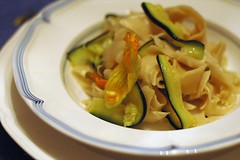
Photo by Melissa Schneider
Call this a two-week weekly wine wrap-up: I never got up last week’s. Samples are marked with an *.
* 2004 McWilliams Hanwood Estate Merlot, Southeastern Australia - ~$9
One-dimensional jammy fruit and a raisiny character make for a decent but not memorable wine. Light tannins and a refreshing acidity make it food friendly, but there are better wines for the price.
* N/V Cameron Hughes “Lot 25” Sparkling Wine, Carneros, California - $20
I pictured green apples served with shortbread when I tasted this light sparkler, but another taster at the table said it had a bitter finish and a grapefruit flavor. I paired this wine with the appetizer platter I served at a dinner party.
2003 Josef Ehmoser “Hohenberg” Grüner Veltliner, Donauland, Austria - (bought on clearance)
You can taste the blistering heat of the 2003 vintage in this wine: more stone fruit and dried apricot flavors than normal, lower acidity, and a heavy, creamy weight. In the end, that was a good match for the Meyer lemon papparedelle, zucchini, and squash blossoms I served, but it’s odd to taste a flabby Grüner Veltliner.
2001 Bürgerspital Zum HL. Geist Würzburger Stein “Hagemann” Riesling Spätlese Trocken, Franken, Germany - (price forgotten)
I bought this wine for its packaging: Franken wines come in a unique, round-bellied bottle called a Bocksbeutel, which translates to “goat scrotum.” Once that topic exhausts itself, you’ll find a rush of older Riesling character in the wine itself: petrol and pine and wax, oh my. This bottle also had a bit of the nutty character that comes with oxidation. The wine isn’t very complex, but it went well with roasted pork belly.
* 2006 Groth Sauvignon Blanc, Napa, California - $19
One of my favorite California Sauvignon Blancs, this wine combines the grassiness and green apple flavors of Old World Sauvignon Blancs with the heavier weight and hints of butter aromas more typical of the New World. The short finish gives a flare of heat, perhaps from the 14.5% alcohol. Drink it with shellfish and other types of light seafood.
2004 Domaine Germain Pére et Fils, Burgundy, France - (gift?)
Pretty flowers and spices dominate this aromatic wine, and I couldn’t get over the idea that it smelled like Pez candy. Lovely mineral flavors wash the palate, and a bit of cheese rounds out the medium-long finish.
* 2003 Bridlewood Syrah, Santa Ynez, California - $40
I didn't like cough syrup as a kid, and I don’t like it as an adult. So I wasn’t fond of this rich, berry-flavored wine and its scorching hot finish, but I was happy to find some of the smoke and meat aromas so often lacking in California Syrah. Oddly, I also found green notes: California growers ripen these grapes almost to raisins, so maybe it came from the oak.
N/V Saison Dupont - $9/750 ml
One of Belgium’s best and most approachable beers, Saison Dupont offers a whiff of vanilla, a burst of flowery hops, and a wave of tingly citrus. The creamy beer tastes a bit like lemon juice, with a little hoppy bitterness and a pleasant maltiness at the end. Drink with just about anything: This beer has enough weight and flavor to stand up to all but the most overpowering dishes.
2005 Adegas D'Altamira “Seleccion” Albariño, Rias Baixas, Spain - $20
Transport yourself to Spain’s Atlantic coast with this refreshing and simple wine. The green apples and minerality will fit right in with a tapas meal or a light dinner.
* 2006 Gascon Malbec, Mendoza, Argentina - $10
This well-balanced wine will seduce anyone who loves meaty, earthy wine. Bacon, thyme, mushrooms and a squirt of vanilla round out the taste, and searing acidity mixed with mild tannins make this a food-friendly drink. Pair it with roasts and rich pasta sauces.
Bonny Doon Tasting
Peter at Vintage Berkeley sent me an email to tell me that Randall Grahm, owner of Bonny Doon, was stopping by the store to pour some of his new wines. He’s converting the whole winery to a biodynamic operation, and I wanted to taste the results. (Also, I had spoken with him by phone three days earlier on a separate topic, and I wanted to give him a face for my name.)
In the end, we bought three of the Ca' del Solo bottles: the weighty and rich Albariño, the floral and crisp Moscato Giallo, and the earthy and intense Sangiovese. I’ve long been a fan of Randall’s attitudes, but I can’t recall his earlier versions of these wines. At any rate, the new batch is delicious. But the star of the day was the 1990 Old Telegraph that Randall brought as “something special.” Seventeen years haven’t dented this all-Mourvedre wine, which still has lively fruit and mellow tannins.
Labels: Wine Tasting Note, Wine Wine Wine









